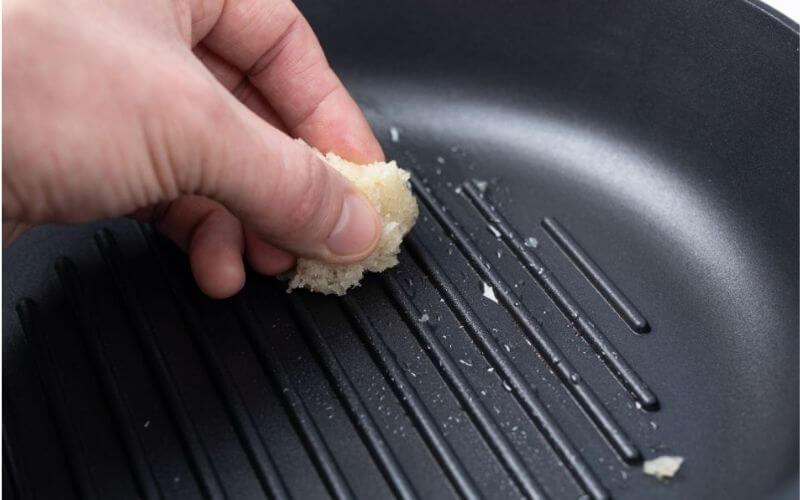It doesn’t matter if you invest a lot of money on your nonstick griddle and pans only to clean them in the dishwasher and ruin them within a few months!
Yes, the griddle might look like a hefty kitchen tool that can withstand the water pressure of the dishwasher, but we can assure you, it’s not.
Just because your griddle looks clean, doesn’t really mean it’s properly clean. Also what about those moments when you have totally burned your food and can’t seem to scrape off the layer?
Well, aren’t you in luck as we have a simple and quick guide to make cleaning very easy and efficient. Let’s be honest, cleaning isn’t the most fun thing we can do with our time. So why not make it as fast as possible?
In this article, we will find out, how to clean non stick griddles to make them look brand new again! Let’s remove the burnt-on gunk together.
You may also like: How to clean sticky grease off kitchen cabinets
What You Need for Cleaning a Non-Stick Griddle
- Sponge
- Dish soap
- Washcloth
- Silicon scrubbing brush
- Hot water
- Vinegar
- Baking soda
- Napkin
How to Clean Non-Stick Griddle
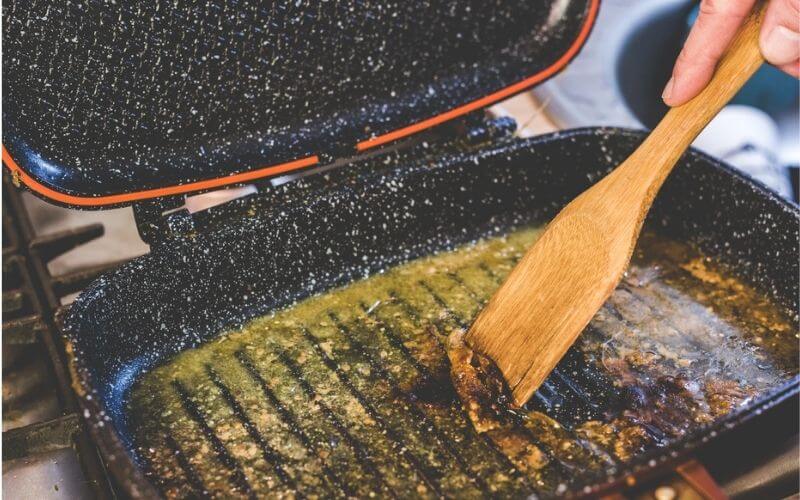
- If you have just used your non-stick griddle pan, it’s better to let it cool down completely before cleaning it. You can make your dinner and then go enjoy the food. By the time you’ll be done with your food, the grilled will be ready for cleaning.
- Non-stick griddles have a coating on top that can get damaged pretty easily. So you should hand wash your griddle.
- Take a silicone scrubbing brush or sponge and remove the stubborn grease off of the griddle.
- You might need to scrub with some elbow grease if the pan is severely burnt. You can use baking soda or vinegar to weaken the tricky areas if necessary
- After you have removed the excess bits of burnt food from the griddle, use dish soap to remove all traces of oil and grease.
- Rinse the griddle thoroughly under running water and get rid of all soapy residue. There shouldn’t be any traces of detergent left on the griddle as it can damage the surface of the pan.
- Use a cotton kitchen towel to dry the pan completely before you store it.
- Try to hang your griddle and pans in hooks instead of storing them in a closed cupboard. Open storage helps to keep the griddles moisture-free.
How to Remove Burnt Food from Non Stick Pan
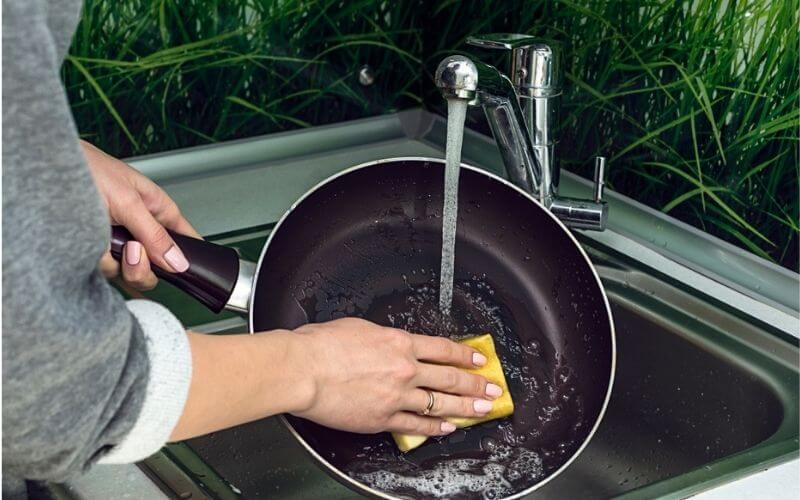
Probably one of the biggest nightmares for any homecook is cleaning the pots and pans afterward. And if it’s burnt severely with food and grease, we just don’t feel like doing it.
Hot Water and Soap:
In most cases, you might not need to do anything too fancy to remove the burnt grease. Our day-to-day cooking doesn’t usually cause too much damage to the griddle.
For light burnt food, all you need is some lukewarm water and dish soap. After the pan has cooled down completely, add a few drops of dish soap and lukewarm water into the pan and let it sit for 5-10 minutes.
After that, use a silicone scrubber to remove the burnt food. It should come off without much effort.
Salt:
You need some kind of mild abrasive to remove burnt food from the pan. Salt is an excellent accessible option that can be found in every household.
To use salt, first cool down the pan completely and wet the burn with water. Then sprinkle some salt only on the burnt area and leave it for 10-15 minutes. Then use a scrub to remove the burnt grease off of the pan.
Baking Soda:
When the griddle is very badly burnt and you can not remove the food with either of those methods, baking soda is your savior. It can remove any tough grease and stickiness from your pan. You might need to put some muscle into the act but it will be worth it.
Simply covers the burned area with a paste of baking soda. Then use some foil paper to cover the griddle and leave it for 20 minutes. Be careful to not leave the pan for longer than half an hour.
Bicarbonate of soda is quite harsh so leaving for too long can damage the non-stick layer. The alkaline substance can cause the non-stick to chip off.
After 20 minutes, use a scrubber and scrub till everything looks squeaky clean. Rinse under cold water and dry the griddle completely.
How to Clean Non Stick Cookie Sheets
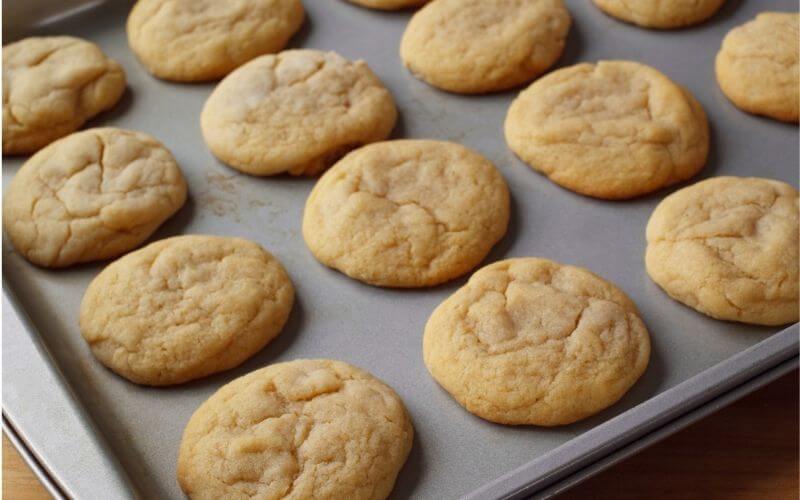
As we all are into baking nowadays, cleaning the cookie sheets has become a very regular thing to do. So here’s how you do it the right way:
- Sprinkle a generous amount of baking soda on top of the cookie sheets
- Make sure the layer is thin and evenly distributed. Emphasis on the soiled areas of the sheets more.
- Pour white vinegar on top of the baking soda. It will start to fizz up but that’s totally normal.
- Let the mixture sit for 30-40 minutes like this. The fizz will help to remove all the tough stains and marks from your cookie sheets.
- After the pan has been sitting for a while, grab your nylon scrubber and start to scrub the sheets in circular motions. Get in there and use some elbow grease!
- The baking soda and vinegar will act as a natural detergent and remove all the burnt food particles from the cookie sheets.
- Once you have scrubbed off the whole pan, rinse it off under running water. You can use dish soap to get rid of any grime and grease.
- At this point, you will notice your cookie sheets are looking all shiny and clean. This is our favorite and most affordable way to get the cleaning done.
Non Stick Griddle Cleaning Tips
- Always make sure that the griddle is cooled down completely before cleaning it. The drastic temperature change can be damaging to the non stick layer. That’s what you shouldn’t put your hot pan into the cold water to clean.
- Never use a metal scraper, knife, or scouring pad to clean your nonstick griddle. Abrasive sponges can damage the non stick layer severely and it will start to peel off. So always use soft sponges or cotton fabrics.
- Use a scraping tool to scrape off burnt food from the griddle surface. Never use metal spatulas. There are many affordable pan scrapers that make this job very easy.
How to Clean an Electric Griddle
An electric griddle can get a little too dirty in time. But how do you clean it properly — without damaging anything in the process? Here’s how:
- Remove Debris From the Surface
You can remove debris from the surface in two ways: either through heating the griddle up or letting it be cleaned unplugged.
When it’s heated up, you can scrape off the excess grease with a flat spatula, removing the debris along the way.
If you choose to unplug it, let it fully cool off first. You may have to wait for several minutes for this.
Use a paper towel or a piece of cloth to remove surface debris. Rub lightly to get rid of oils, crumbs, and liquids.
- Use Soap and Sponges
For a more thorough cleaning, it’s time to get your soaps out.
Heat up some water first, then make a mixture of baking soda and vinegar with the heated water. This mixture will help in fully taking away the debris you have stuck on your electric griddle. Any burnt food will be taken away, too!
If there is more debris that is stuck to the surface, use a blend of soap and the baking soda mixture to clean it up. You can also use the spatula again to gently scrape it off. If the remaining debris is really stubborn, let it sit in the water first before attempting to scrape and clean it up again.
- Rinse and Let Sit
Rinse the griddle thoroughly with warm water. Once all the soap is gone, wipe it down with a piece of cloth or paper towel. To make sure it fully dries, let it sit first before coming back to the cleaning process!
- Finish Off The Cleaning Process with Cold Water
To make sure all the grease is gone, rinse the griddle again with cloth and cold water. Let it dry again — this time, your griddle is fully clean and ready for brand-new use!
If your electric griddle is non-stick, make sure not to use any metal or abrasive cleaning accessories. Instead, use a cleaning pad, scrub sponge, or piece of cloth.
How to Clean a Stove Griddle
A stove-top, cast-iron griddle is also quite straightforward to clean. Just follow the steps below:
- Let Cool
After using the griddle, set it aside. Don’t worry too much about the cleaning process at this step and let it cool first. Take out paper towels, cloth or sponge, soap, scraper, hot water, and vegetable oil. Yes, some seasoning is needed if you want your food to not stick to the griddle when cooking!
- Clean Away Surface Debris
Grease, oils, crumbs, and liquids should be wiped away with paper towels or cloth. A scraper may also be used to loosen stuck-on food and debris. Don’t use a metal scraper — you may risk damaging your griddle!
- Wash and Dry
Use a sponge to thoroughly clean the griddle’s surface. Some soap, like dishwashing liquid, may be necessary for this portion. Rinse with hot water and dry with more paper towels or a piece of cloth.
- Season and Store
Before stowing away your griddle, get around a teaspoon of vegetable oil, and use paper towels to distribute it throughout the surface of the griddle. Wipe away the excess oil before heating the griddle up on your stove for five to ten minutes.
After seasoning your griddle, set it aside to cool. Once it’s cool and dry, store the griddle in your cupboards or pantry. Your cleaning is all done!
Care and Maintenance Tips for Non-Stick Pans
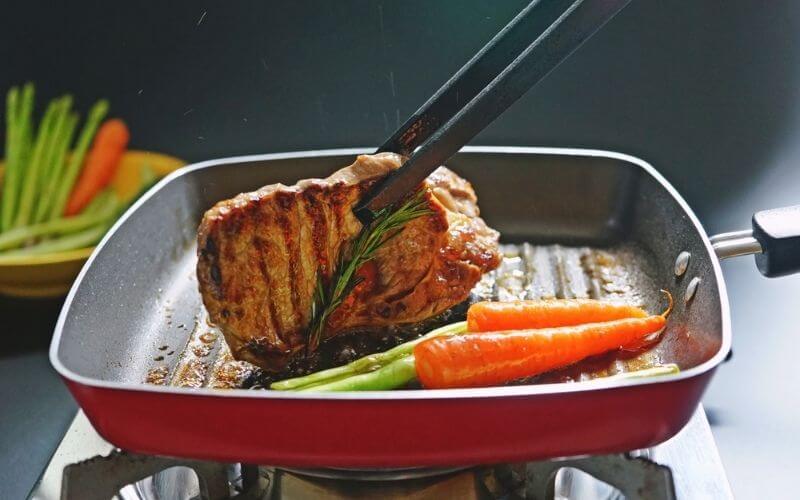
- Don’t use the dishwasher to wash your nonstick pans and griddles. The dishwasher uses a lot of water pressure to clean pans.
This can damage the non stick layer. So hand wash your kitchen utensils.
- Let your pan dry completely before you decide to store it in the cupboard. Moisture can be damaging to the pan so make sure it’s totally moisture-free.
- Apply oil after washing and drying. Apply a teaspoon of vegetable oil and use a paper towel to gently apply a thin layer of it. This helps to keep the non-stick surface protected.
- Clean your pans after each use. This might seem like too much work but you will notice a longer lifespan for your pots and pans. Most of the time you might not even need water and soap to clean. Gently wipe the surface with a paper towel and that’ll be enough.
- Never heat your pans empty. What we mean by that is, always apply a bit of oil or butter to the pan before heating it up. Even though it’s nonstick, it still needs a lubricant to keep it from being scratched.
- No metal utensils are allowed. Only use wooden or silicone spatulas as they are not abrasive on the pan surface.
- Do not stack your pots and pans in the cupboard. This can cause them to scratch each other and ruin the nonstick layer.
Instead, hang them on the kitchen wall or put paper towels in between each pot and pans before stacking.
Frequently Asked Questions
01. Will Vinegar Hurt Non-Stick Pans?
Standard nonstick pans are designed to be quite resistant to abrasive ingredients, vinegar won’t be able to damage them. If you have a PTFE/Teflon non stick pan, vinegar is nothing to be worried about.
Other types of nonstick pans such as aluminum and ceramic are also unaffected by vinegar. Vinegar is an excellent cleaning agent and can remove tough stains pretty easily.
So be sure to use it for your non-stick pans and pots. You can use vinegar for your cast iron pans as well. As it gets diluted with water, it can not damage the surface.
02. Why are Eggs Sticking to My Non-Stick Pans?
Even if you are using a nonstick pan, you need to use at least a few drops of oil. Nonstick pans are not supposed to be used without any oil or butter. They only reduce the amount you would need normally.
So if your eggs are sticking to your nonstick pan, chances are you are not using any oil to cry them. Eggs are like glue, so it’s no surprise that they are sticking to the pan.
The oil acts as a protective layer between the nonstick and the eggs. It helps to not let the egg bond with the metal. Try using a few drops of oil to see whether that solves the issue or not.
Another reason can be, you are adding the eggs to a cold pan. Let the pan get hot enough before adding your eggs. This way it won’t stick to the surface.
03. Does Olive Oil Ruin Non-Stick Pans?
We are not sure where this myth comes from, but a lot of people believe olive oil damages the non stick layer. Maybe they think so because olive oil is quite acidic in nature.
But don’t worry, olive oil can not damage your nonstick pots and pans. In fact, it’s a good idea to rub a teaspoon of olive oil on your cold pan before you use it.
This helps to keep the non stick layer protected from any burn or scratch. The oil acts as a lubricant and keeps the pan all shiny and new. Any type of oil is okay to use on nonstick surfaces.
04. How Do I Make My Non-Stick Pan Non-Stick Again?
If your nonstick pan has lost its smoothness over time, maybe it’s because of the grime build-ups from all the cooking. If you tend to burn your pan a lot, a thin layer of burn can stay on the surface and cause it to feel uneven and textured.
To fix that, pour a cup of water and 2-3 tablespoons of baking soda into the pan. Then add half a cup of vinegar to it. Let it sit on the stove for 10 minutes until it starts to boil.
When it begins boiling, bring it out of the stove and let it cool down completely. Then wash as usual with a scrub and dishwashing liquid.
Then apply a teaspoon of vegetable oil on the surface and rub using your fingers or a paper towel. The nonstick should feel smooth again.
If your pan does not feel nonstick after this, maybe it’s time to toss out this pan. All nonstick pans have an expiration date. When the non-stick layer starts to peel off, it becomes toxic and you shouldn’t use it anymore. So be careful of it.
05. Should Griddle be Sticky after Seasoning?
No, it should not. If you are using a cast iron griddle and season it to keep it in its top shape, it should not feel sticky.
Cast iron pans are highly porous, so when you use oil to season it, it absorbs the oil and creates a resistant coating on top. The heat sort of solidifies the oil and produces a durable coating.
This coating feels smooth to the touch and not sticky whatsoever. If your griddle feels sticky after seasoning, chances are you applied too much oil to season the griddle.
You only need a teaspoon of oil on a griddle. As you coat the oil using a paper towel, most of it gets absorbed and only a little stays on the cast iron surface. This is why it never feels sticky or greasy.
Try washing the pan and reseasoning using less oil next time. Make sure to remove the excess oil with a towel every time you season.
Takeaway
Didn’t we say cleaning non stick griddles is super easy to do? Not only are these tips easy to follow, they actually extend the life of your griddle pans. As it’s the most used item in our kitchen, we need to take proper care of it!
Was it helpful? Do you have some tips of your own? Comment down below to let us know!
More Related Guides:
